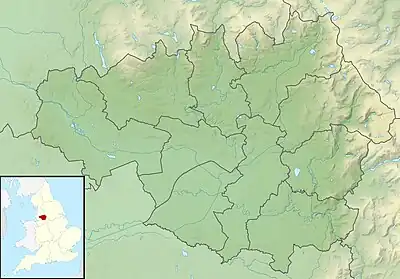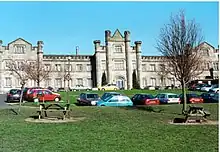Werneth Hall
Werneth Hall is a Grade II* listed privately owned Jacobean manor house in Oldham, Greater Manchester, England.[1]
| Werneth Hall | |
|---|---|
 Location of Werneth Hall in Greater Manchester | |
| Type | House |
| Location | Werneth, Oldham, Greater Manchester |
| Coordinates | 53.53361°N 2.12872°W |
| Built | 17th century or earlier |
| Architectural style(s) | Jacobean |
| Governing body | Privately owned |
Listed Building – Grade II* | |
| Official name | Werneth Hall |
| Designated | 25 October 1951 |
| Reference no. | 1201652 |
History
In the reign of Henry III, Alwardus de Aldholme held the manor of Oldham and land in Werneth (Vernet). In the 13th century, Oldham was documented as a manor held from the Crown by a family named Oldham. The Oldhams were relatives of the Bishop of Exeter, Hugh Oldham.[2]
Richard de Oldham was lord of the manor in 1354 and the Hall, park and estate passed to his daughter, Margery de Oldham, who married John de Cudworth in the 1370s. The estate passed to their son, John, and to his descendants one of whom, Ralph Cudworth (d.1572), was the father of the Anglican theologian Ralph Cudworth and grandfather of the Cambridge Platonist Ralph Cudworth. The estate remained in the Cudworth family until Joshua Cudworth (d.1710) sold it to Sir Ralph Assheton (1651–1716) of Middleton in 1683.[3][4][5]
Assheton gave the estate to his daughter, Catherine Assheton (d.1728), who married Thomas Lister (1688–1745) of Gisburn Park, Yorkshire. The estate passed to their son Thomas Lister (1723–61) and then to his son Thomas Lister, Lord Ribblesdale (1752–1826) who sold it to Parker and Sidebottom of London, for £25,500, in 1792.[4]
In 1795, the Werneth Hall estate was purchased, for £30,000, by the cotton manufacturer John Lees (d.1823) of Oldham.[4] His son Edward Lees (d.1835) was succeeded as owner of the Hall and lord of the manor by his sons the MP John Frederick Lees (1809–1867) and George Lees.[4][6] The estate included a park until around 1844 when the Hall property was separated from the land and the latter became the later public Werneth Park in 1936.[7]
Architecture
There have been three buildings on this site since the Middle Ages. The first Werneth Hall (probably timber and plaster) was destroyed by fire in 1456. The house was rebuilt and was in use until at least the 1590s.[7]
Most of the third (present) building was built between 1590 and 1625, and has been extensively altered. It is in sandstone with a roof partly in Welsh slate and partly in stone flags. There are two storeys with a cellar, a main range with two cross-wings, coped gables and later extensions. The windows are mullioned and transomed. The entrance has a moulded architrave and to the left an inserted French window.[8][9][1]
References
- Historic England (1986). "Werneth Hall, Oldham (1201652)". National Heritage List for England. Retrieved 6 March 2021.
- Butterworth, Edwin (1981). Historical Sketches of Oldham. E.J. Morten. ISBN 978-0-85972-048-9.
- "Proceedings". Transactions of the Lancashire and Cheshire Antiquarian Society. 8: 147–150. 1890.
- "The parish of Prestwich with Oldham: Oldham | British History Online". www.british-history.ac.uk. Retrieved 14 March 2021.
- R.E. Stansfield-Cudworth, 'Gentry, Gentility, and Genealogy in Lancashire: The Cudworths of Werneth Hall, Oldham, c.1377-1683', Transactions of the Lancashire and Cheshire Antiquarian Society, 111 (2019), 48–80.
- Lewis, Samuel (1848), "Werneth", 'Weobley - Westby', in A Topographical Dictionary of England, British History Online, pp. 513–517
- "Werneth Park". Parks & Gardens. Retrieved 13 March 2021.
- Hartwell, Clare; Hyde, Matthew; Pevsner, Nikolaus (2004), Lancashire: Manchester and the South-East, The Buildings of England, New Haven and London: Yale University Press, p. 548, ISBN 0-300-10583-5
- "Werneth Hall". British Listed Buildings. Retrieved 5 March 2021.
.JPG.webp)
